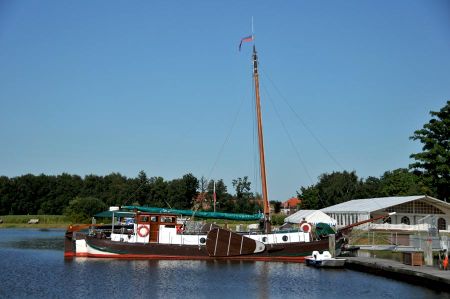Along the Fehn canals through the moor to Barßel
- Written by Portal Editor
The following day brought us another wonderful excursion, this time through the Ammerland to Barßel. During our hearty breakfast with Mariechen and Jochen, we decided to go on a day trip along the Fehn canals through the peat areas of East Friesland and Ammerland, which are hardly used any more today.
We drove via Friedeburg and Marx to Neuenburg, where we turned right after leaving the town in the direction of Astederfeld. Changes in the landscape quickly become apparent and after just a few kilometers we see the first peat extraction areas of the Stapeler Moor.
Livelihood of moor farmers endangered by theft of flocks of sheep
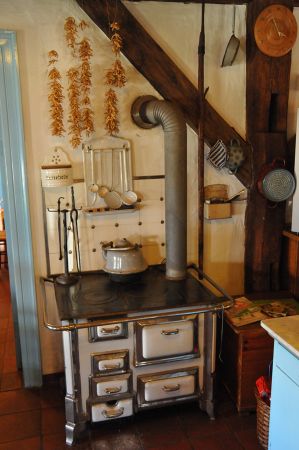 As in many areas of our life today, peat extraction is a double-edged sword: income and earnings of the local population on the one hand and preservation of the peat areas for reasons of nature conservation and the associated ecosystems on the other. It is often difficult to find the right boundary lines here. The former overexploitation of nature has long since ceased to take place. Today, only certain areas are still approved for peat extraction and the extraction heights are also strictly regulated. Initially, peat extraction was not a priority for the livelihood of the local population, because originally the landlord-free farmers in the villages around Barßel who lived here were occupied with sheep farming and fishing. Only when raids by the Oldenburgers in 1522 and 1538 threatened the livelihood of the moor farmers by stealing the flocks of sheep to such an extent that it was almost impossible to survive did the population begin to secure their livelihood with the peat trade.
As in many areas of our life today, peat extraction is a double-edged sword: income and earnings of the local population on the one hand and preservation of the peat areas for reasons of nature conservation and the associated ecosystems on the other. It is often difficult to find the right boundary lines here. The former overexploitation of nature has long since ceased to take place. Today, only certain areas are still approved for peat extraction and the extraction heights are also strictly regulated. Initially, peat extraction was not a priority for the livelihood of the local population, because originally the landlord-free farmers in the villages around Barßel who lived here were occupied with sheep farming and fishing. Only when raids by the Oldenburgers in 1522 and 1538 threatened the livelihood of the moor farmers by stealing the flocks of sheep to such an extent that it was almost impossible to survive did the population begin to secure their livelihood with the peat trade.
Barges were initially used for transport
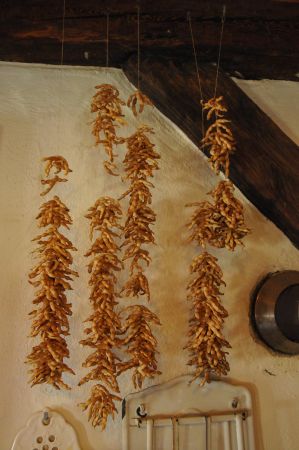 The so-called peat cutting was a physically strenuous work in which pieces were cut out of the peat in layers and placed in small stacks to dry next to the cutting area.
The so-called peat cutting was a physically strenuous work in which pieces were cut out of the peat in layers and placed in small stacks to dry next to the cutting area.
Over time, these piles of pieces of peat lost their main component, water, and could then be transported away. Barges were initially used for transport, which were mostly transported by horse-drawn power or sails on the created drainage canals.
Depending on the firmness of the pieces of peat, they were used for burning in stoves (comparable to wood) to heat the rooms, a use that hardly exists today. We only know that peat is used as fertilizer or to improve the soil quality in the garden and for planting or potting.
Barßel is located in a former swamp area
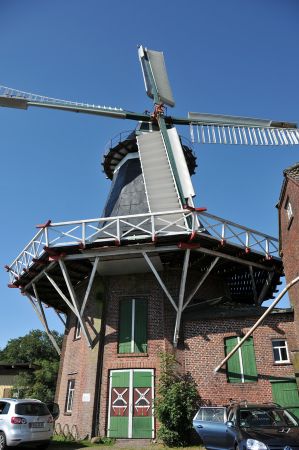 After a short stop at a peat extraction area, our route continues along the Fehn Canal in the direction of Barssel, which we reach after a short drive.
After a short stop at a peat extraction area, our route continues along the Fehn Canal in the direction of Barssel, which we reach after a short drive.
Barßel is located in a former swamp area about 45 kilometers from Cloppenburg and about 40 kilometers from Dollart and the Ems estuary. Since the entire region is only about one meter above sea level, there was a high risk of flooding until the 19th century, as the drainage canals drained directly into the Ems and thus into the North Sea.
The Aue rivers flowing around Barßel, which is popularly known only as Barßel Deep, and Soeste also contributed to this danger.
We drove to Barßeler Hafen
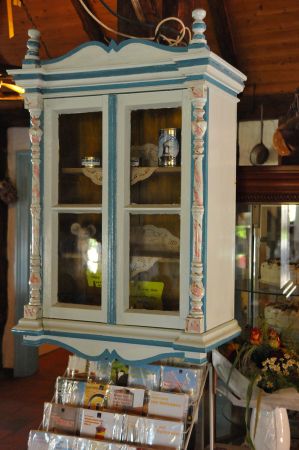 With the influx of refugees and displaced persons at the end of the Second World War, there was also the problem of providing the newcomers with enough settlement space in the area around Barßel.
With the influx of refugees and displaced persons at the end of the Second World War, there was also the problem of providing the newcomers with enough settlement space in the area around Barßel.
From 1957, several drainage projects were carried out on the Soeste, which also served to protect against flooding, because the tidal differences in the North Sea caused by the Ems, the Jümme, the Barßeler Tief and the Soeste were still noticeable.
We drove to Barßeler Hafen, which we had completely misjudged in terms of size and how frequented it was by other boat owners. In the meantime, many leisure captains use the really huge canal network for their hobbies: yachts and boats.
In addition to a passenger ship that regularly sails in the direction of Emden, there are also numerous privately owned ships in the port of Barßel. We were even able to discover a lighthouse, but quite unusual so far from the sea.
Death for the Barßeler captain Hans Lamps
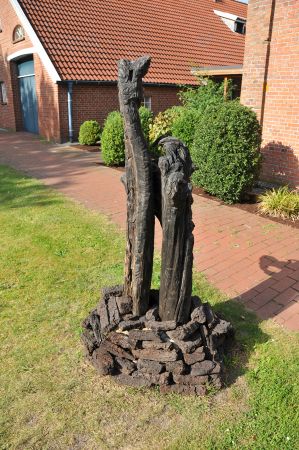 Talking to locals, we also learn that there were a number of well-known captains who had found a home in Barßel. One name was that of Captain Johann Dänekamp, who disappeared in 1978 in an unexplained accident along with his 28-man crew in the North Atlantic. The 261 meter-long ship "München", which disappeared with the people, has not yet been found. Another shipwreck in 1994 resulted in the death of Captain Hans Lamps from Baressel.
Talking to locals, we also learn that there were a number of well-known captains who had found a home in Barßel. One name was that of Captain Johann Dänekamp, who disappeared in 1978 in an unexplained accident along with his 28-man crew in the North Atlantic. The 261 meter-long ship "München", which disappeared with the people, has not yet been found. Another shipwreck in 1994 resulted in the death of Captain Hans Lamps from Baressel.
We heard all this story with great amazement because the North Sea seemed so far away from here. Our return trip was similar along the canals, but we stopped for coffee and cake at the Rütteler Mühle, which is also a great local recreation destination. In addition to the main mill, which is still in operation, there are a few examples of mills on display here as working models, which show some examples of local mill types from the Dutchman to the post mill. The homemade blueberry cake was to die for.
Coordinates: 53° 10′ N, 7° 45′ E
Please read as well:
Greetsiel - twin mills and traditional fishing boats
The Ohrid Lake and its bubbling underground springs
-
 Barßel Fehnchannel and Harbour
Barßel Fehnchannel and Harbour
Barßel Fehnchannel and Harbour
Barßel Fehnchannel and Harbour
-
 Barßel Fehnchannel and Harbour
Barßel Fehnchannel and Harbour
Barßel Fehnchannel and Harbour
Barßel Fehnchannel and Harbour
-
 Barßel Fehnchannel and Harbour
Barßel Fehnchannel and Harbour
Barßel Fehnchannel and Harbour
Barßel Fehnchannel and Harbour
-
 Barßel Fehnchannel and Harbour
Barßel Fehnchannel and Harbour
Barßel Fehnchannel and Harbour
Barßel Fehnchannel and Harbour
-
 Barßel Fehnchannel and Harbour
Barßel Fehnchannel and Harbour
Barßel Fehnchannel and Harbour
Barßel Fehnchannel and Harbour
-
 Barßel Fehnchannel and Harbour
Barßel Fehnchannel and Harbour
Barßel Fehnchannel and Harbour
Barßel Fehnchannel and Harbour
-
 Barßel Fehnchannel and Harbour
Barßel Fehnchannel and Harbour
Barßel Fehnchannel and Harbour
Barßel Fehnchannel and Harbour
-
 Barßel Fehnchannel and Harbour
Barßel Fehnchannel and Harbour
Barßel Fehnchannel and Harbour
Barßel Fehnchannel and Harbour
-
 Barßel Fehnchannel and Harbour
Barßel Fehnchannel and Harbour
Barßel Fehnchannel and Harbour
Barßel Fehnchannel and Harbour
-
 Barßel Fehnchannel and Harbour
Barßel Fehnchannel and Harbour
Barßel Fehnchannel and Harbour
Barßel Fehnchannel and Harbour
-
 Barßel Fehnchannel and Harbour
Barßel Fehnchannel and Harbour
Barßel Fehnchannel and Harbour
Barßel Fehnchannel and Harbour
-
 Barßel Fehnchannel and Harbour
Barßel Fehnchannel and Harbour
Barßel Fehnchannel and Harbour
Barßel Fehnchannel and Harbour
-
 Barßel Fehnchannel and Harbour
Barßel Fehnchannel and Harbour
Barßel Fehnchannel and Harbour
Barßel Fehnchannel and Harbour
-
 Barßel Fehnchannel and Harbour
Barßel Fehnchannel and Harbour
Barßel Fehnchannel and Harbour
Barßel Fehnchannel and Harbour
-
 Barßel Fehnchannel and Harbour
Barßel Fehnchannel and Harbour
Barßel Fehnchannel and Harbour
Barßel Fehnchannel and Harbour
https://www.alaturka.info/en/germany/lower-saxony/5673-along-the-fehn-canals-through-the-moor-to-barssel?tmpl=component&print=1&layout=default#sigProId8f8a5cbbde
